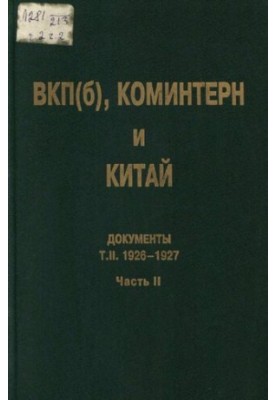VKP(b), Comintern and China. T. II. VKP(b), Comintern and National Revolutionary Movement in China. 1926-1927. At 2 p.m. 2
 Instant download
Instant download
after payment (24/7)
 Wide range of formats
Wide range of formats
(for all gadgets)
 Full book
Full book
(including for Apple and Android)
VKP(b), Comintern and China. T. II. CPSU(B), Comintern and National Revolutionary Movement in China. 1926-1927. At 2 p.m.. H. 2" is a deep and multifaceted study that reveals the complex relationship between the Soviet communist leadership, the international communist movement and the Chinese national revolutionary process in an era of rapid changes in the 1920s. The author, whose name remains unknown, created a work that not only immerses the reader in historical events, but also helps to understand the motivation, strategy and internal contradictions of the party leaders of the time. This book is a real treasure for those who are interested in the history of the communist movement, Soviet diplomacy and revolutionary events in Asia. It covers in detail the period from 1926 to 1927, when China was experiencing turning points in its history, and the influence of the CPSU(b) and the Comintern became increasingly noticeable. The author masterfully shows how Soviet policy and ideas of communism influenced the development of national liberation movements in China, as well as how Chinese revolutionary forces reacted to external interference and internal challenges. The book is especially valuable for historians, political scientists, students and anyone who wants to understand the mechanisms of formation and implementation of the international communist strategy. It is suitable for readers aged 18 years and older, interested in the history of the 20th century, revolutionary movements and international relations. Fans of complex political scenarios, analysts and Marxist theorists will find rich material for reflection and research here. In addition, the book will be of interest to those who appreciate a deep analysis of historical events, based on documentary sources and professional interpretation. The topics raised in this paper range from the internal politics of the C.P.S.U.(B.) and the role of the Comintern in shaping Chinese revolutionary strategy to the interaction between various revolutionary groups and their leadership figures. Particular attention is paid to the ideological struggle, diplomatic maneuvers and tactical decisions that determined the fate of the Chinese revolutionary movement during the critical period. The author masterfully shows how external factors and internal contradictions influenced the course of events, creating a complex mosaic of historical truth. The style of the author is distinguished by analytical depth and accuracy, while avoiding dryness and excessive academic rigor. His approach allows the reader not only to get acquainted with the facts, but also to feel the spirit of the era, to understand the motivation of the participants in the events and to assess the significance of each decision. The book shows a special attention to detail, which makes it a valuable source for those who are looking not only for a superficial description of events, but also for their internal causes and consequences. VKP(b), Comintern and China. T. II. CPSU(B), Comintern and National Revolutionary Movement in China. 1926-1927. At 2 p.m.. H. 2" is not just a historical work, it is a window into the past, which helps to understand how ideas and strategies influenced the fate of entire peoples and shaped the modern history of Asia. This book deserves a place on the shelf for anyone who appreciates in-depth research, analytical approach, and historical truth. Her reading will expand the horizons of understanding of international revolutionary processes and leave behind a desire to learn more about the complex relationship between the Soviet Union, the Comintern and China in an era of great change.
LF/441177086/R
Data sheet
- Name of the Author
- Unknown
- Language
- Russian
- Release date
- 1996
- Volume
- 2 / 2
















